
In March 2024, The Weekly Anthropocene published an interview with Dr. Thomas Klak, a Maine researcher who’s become a leader in the efforts to restore the fungal blight-stricken American chestnut tree (“the Redwood of the East”) through selective speed breeding and genetic engineering. You can read it here!
On April 2, 2024, this writer was fortunate enough to arrange a visit to Dr. Klak’s lab in person, at the University of New England campus of Biddeford, Maine. This article, a quasi-sequel to my previous interview with Dr. Klak, tells of what I found there.
Bright was the midday sun and high my heart as I arrived in the corridor before the American Chestnut Nursery, which turned out to be unexpectedly housed in a UNE building primarily devoted to marine biology. At first glance, the space seemed surprisingly small for such a momentous project, with dozens of precious, potentially blight-resistant chestnut trees of different ages and genetic lineages being cultivated in a lab with the dimensions of a largish suburban living room.
After a hearty greeting (it was the first time we had met in person), Dr. Klak proudly reminded me that this out-of-the-way plant haven on a Biddeford campus was the only lab where quantities of transgenic American chestnuts are being bred indoors. “Not to brag,” Dr. Klak said, grinning widely, “but nowhere else is there this scale of breeding of potentially blight tolerant American chestnuts indoors year-round. Selective speed-breeding! We have overcome seasonality.”
I noticed that marijuana-leaf logos were present on many of the grow lights and other equipment, and he surprised me with the reason why. The highest-end equipment and the most knowledgeable horticulture experts were to be found at the local cannabis supply store, and the economies of scale involved in cost-effectively supplying a growing industry must mean that it’s a lot cheaper to buy cutting-edge cultivation supplies intended for cannabis than cultivation supplies intended for scientific research.
I asked, “Would you say that Maine legalizing cannabis a few years ago has contributed to the success of your chestnut project?” Without hesitation, Dr. Klak responded “Very much so. They [the cannabis community] know what works.” In the distant future, he hopes, the funding might become available to buy out one of the greenhouses equipped for marijuana cultivation in the area and convert it into an extra-large chestnut tree production lab.
Hardly five minutes after arriving, I had already learned something completely unexpected. When Mainers voted to legalize cannabis in 2016, I doubt if a single one was thinking that it would help incentivize the widespread availability of equipment and expertise to support the restoration of lost American forest trees, but it has done.

And lots of equipment and expertise was needed, because keeping American chestnut saplings alive in captivity is by itself a task and a half, without even taking into account the extra innovation needed to entice them to flower and produce nuts multiple times a year.

They like an acidic soil, with Dr. Klak’s lab using a blend consisting of 55% pine bark. (The American chestnut’s native range is mostly determined by the extent of acidic soils in the eastern U.S.). The tap water of the UNE campus has a typical pH of 7.2 - there’s a sink and faucet in the lab - but is carefully acidified down to a pH of 5.5 before it’s used to water the young chestnuts.
Temperature was another major variable to manage. The building’s HVAC system was slightly erratic: the young chestnuts preferred a range of 60 to 75°F, but it was 76°F in the lab when I was there and had reached a high of 78°F recently. (Dr. Klak has had lengthy and ongoing conversations with the helpful building manager and maintenance crew).
Once you’ve got the temperature and pH reasonably stable, there’s the pests. Years of work have mostly defeated waves of different insects and diseases that threatened the health of his seedlings and saplings1. The one pest that they had not yet vanquished at the time of my visit was the “fungus gnats,” but they had found a way to keep them under control. For some mysterious reason, the gnats are irresistibly attracted to bright yellow paper, allowing the easy formation of highly effective glue traps, which explained the dead gnat-studded yellow sticky notes placed around the lab’s saplings.
All this was just to make possible the lab’s real work: the cultivation and breeding of American chestnut trees hopefully genetically resistant to chestnut blight, the fungal infection from Asia that devastated the species in the 20th century.
The core of Dr. Klak’s work to produce a new blight-resistant generation of American chestnuts, as readers of my previous interview will recall, is possible due to a clever gene edit done at SUNY-ESF that inserts into the chestnut’s chromosomes a gene from wheat that codes for oxalate oxidase (“OxO”), the enzyme that can break down oxalic acid. In that interview, we mostly discussed the “Darling” lineage of chestnuts gene-edited in this fashion. On this visit, I learned that focus has shifted to a next-generation “Darwin” lineage, taking the lessons learned from work with the Darling lineage to produce a better transgenic chestnut. The difference with the Darwin lineage is that here, that same OxO gene from wheat comes bundled with a “promoter” gene from poplar trees, which turns on the gene to produce the protective enzyme only when it’s needed, when the tree senses a threat2. This makes the Darwin lineage more biochemically efficient: they only produce defenses when there’s an attack, instead of spending energy on producing it all the time.
The lab is now working intensively to breed “homozygous” Darwin chestnuts, where both parents passed on copies of the transgene to their offspring. In the example Punnett square of flowers above, both parents are heterozygous for the “purple-flowers” trait, with a dominant purple-flowers allele (“B”) and a recessive white-flowers allele (“b”). Heterozygous parents, each with a “hidden” recessive allele, can result in offspring with all-recessive alleles, as shown in the lower right corner of this Punnett square. Dr. Klak and his students are breeding homozygous chestnut trees so that pollen from those trees, put on the flowers of any wild-type chestnut, will guarantee that 100% of the resulting chestnuts will inherit the gene for blight tolerance.
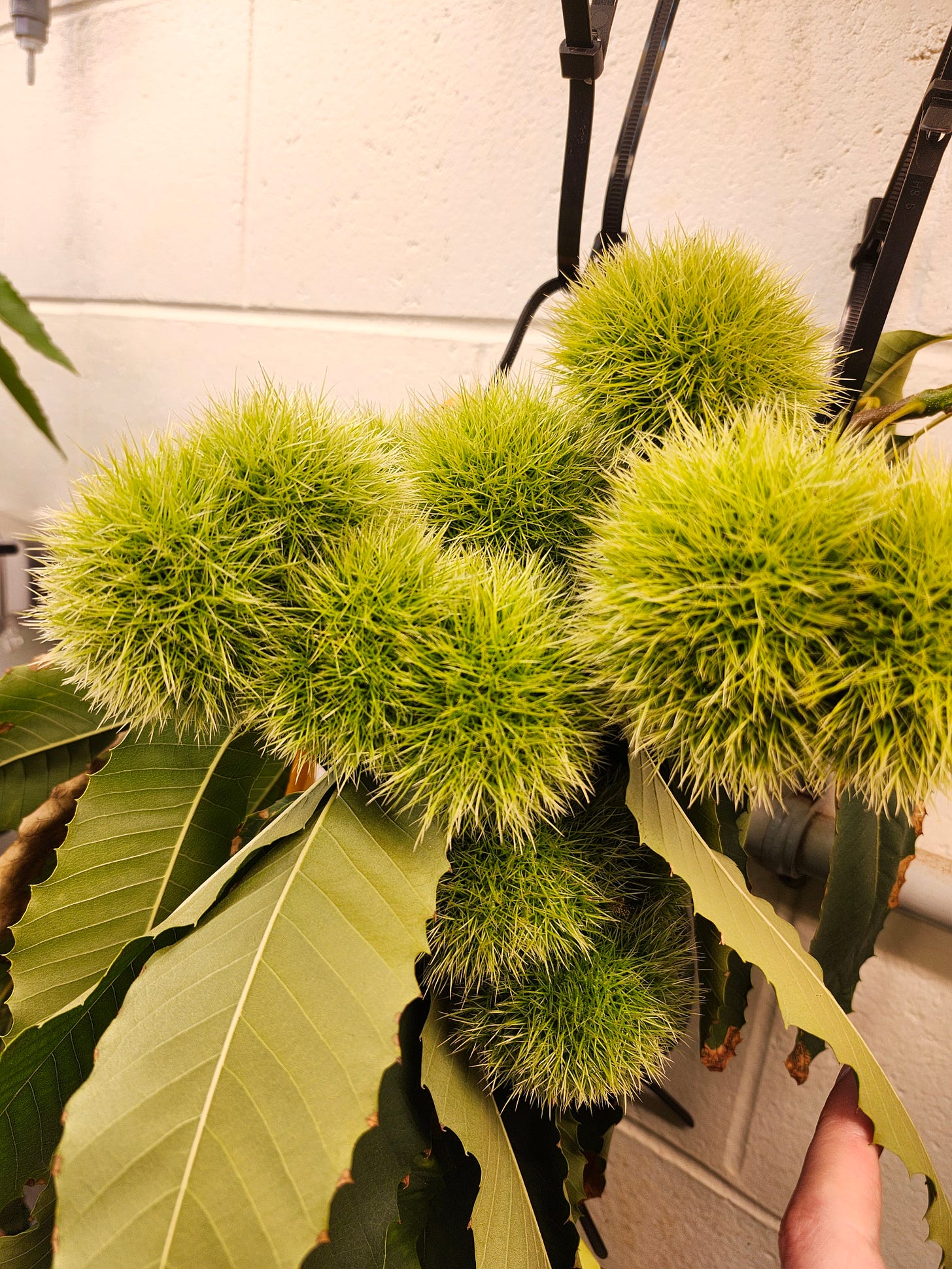
At the end of all that painstakingly managed breeding, you have the precious chestnuts themselves.
The saplings’ precious chestnuts are tenderly packed in Ziploc snack bags, nestled among thick sphagnum moss for moisture and to deter pests. The moss is moistened with water enriched with “Bt” bacteria (Bacillus thuringiensis), which further helps deter the fungus gnats.
And when you want to know whether the chestnuts you’ve got are blight-resistant, you take a little sample of tissue from a nut or leaf and test it with a histochemical assay. The sheer poetic resonance of the histochemical assay process is beautiful in its own right. A little bit of chestnut nut or leaf tissue is plunked in a test tube, then a liquid reagent is added that contains oxalic acid, the very same chemical compound that the blight uses to kill. Then, it changes color if the chestnut tissue has the transgene, because the transgene codes for the OxO enzyme that reacts with oxalic acid, that reaction produces hydrogen radicals, changing the color of the solution. It’s a very direct test: checking to see if the chestnut tissue can do the exact thing it would need to do to survive the blight in the wild!


The lab stores chestnuts, but for maximum efficiency also stores pollen; for a rough human analogue, that’s the “sperm” to chestnuts’ “embryos.” And pollen is so small, they can store a lot of it. In the images above, each slide holds approximately one million grains of pollen, and each vial held four slides. Yesterday they had harvested two vials’ worth of pollen: eight million pollen grains.
Much of that went to a bio-secure fridge near the nursery (pictured above right), with many Ziploc bags full of vials of slides of Darling lineage pollen, and two bags starting to fill with Darwin lineage pollen. And each grain, if it met the right gamete, could provide half the genes to make an entire chestnut tree.
Dr. Klak’s lab has already stored so much pollen from the Darling 54 lineage. The focus now is on collecting the pollen of the more efficient Darwin lineage, but what they’ve frozen already represents a huge genetic reservoir of potentially blight-tolerant American chestnut DNA!
After the fridge, the tour of the main building wound to a close. As we walked from his main speed breeding lab to his secondary greenhouse, Dr. Klak happened to tell me about how fortunate he felt to be able to be involved in a completely different part of the global effort to build a better Anthropocene.

He had a home solar array and a Tesla Powerwall to ensure power reliability, but it often generated more power than he needed. On his phone, he showed me that as we spoke, his panels were generating 1.9 kW but his home was only using 0.4 kW, with his battery entirely full. As a result, he’d signed up (application pending) for one of Maine’s earliest trials of the virtual power plant concept, where his home battery would soon work in concert with many others to act like a single power plant, consistently providing excess power to the grid when needed during the peak of AC-demand in the summer.
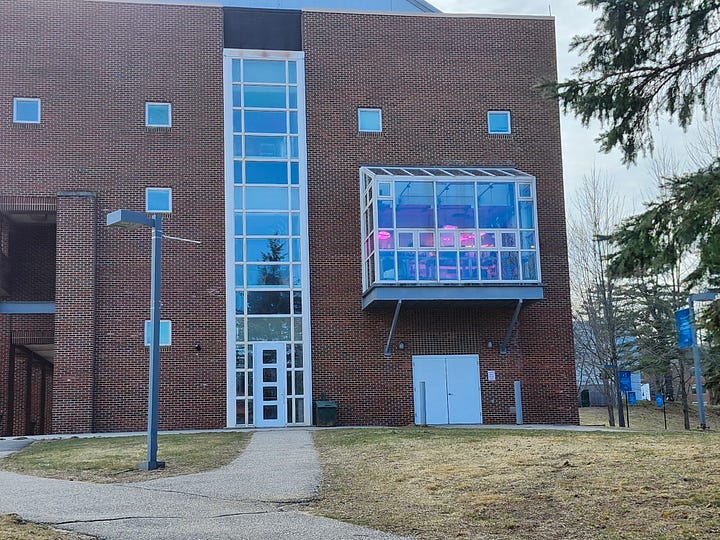
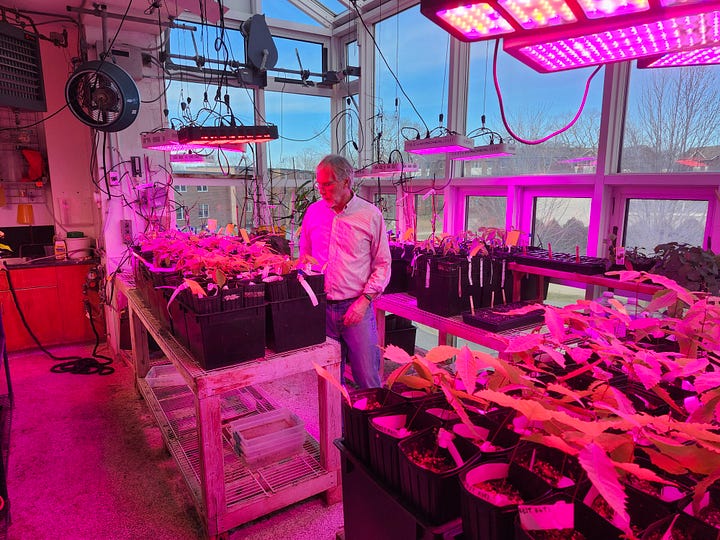
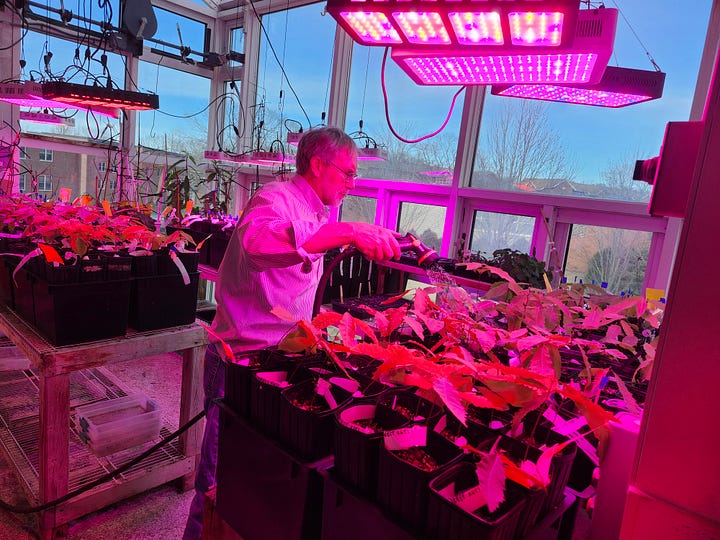
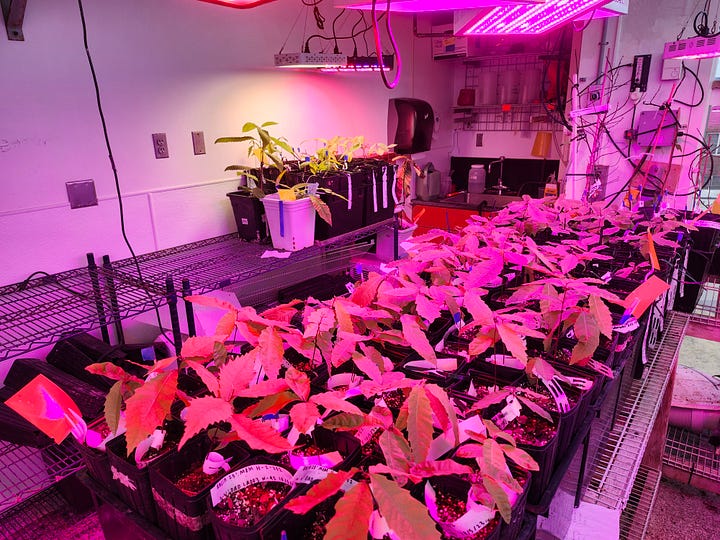
The greenhouse itself contained an array of seedlings, mostly from the Darling lineage, that weren’t genetically cutting-edge but were valuable for learning about juvenile chestnuts’ ability to adapt to field conditions. Some of them had been intentionally left unheated through the winter to test their ability to drop their leaves and hibernate. Others would be planted in one of several testing orchards to see how they interacted with real-life New England landscapes.
Paleoecology has found that the American chestnut was the last of the native hardwoods to repopulate the lands that are now Maine after the end of the last ice age: they had only been established in the Pine Tree State for less than two thousand years before they were effectively wiped out by chestnut blight in the twentieth century. “A hundred years,” clarified Dr. Klak, “by evolutionary standards, is nothing. A disruption of one hundred years is easily overcome by the long-standing ecosystem relationships when we put the American chestnut back on the landscape.”
And Dr. Klak’s field research in Maine may already have rediscovered one of those ancient relationships, in abeyance with the absence of chestnuts but ready to spring back with the new restoration efforts. At their testing woodland in Cape Elizabeth, they had planted wild-type chestnut seedlings in 14 different locations, then waited years with anticipation to see which combination of soils and light levels would result in the best growth. It turned out, surprisingly, that none of that mattered very much. The key factor determining the success of a chestnut tree was whether the site harbored wild-sowed Eastern white pine (Pinus strobus, Maine’s state tree). The chestnuts are better off with less available light, but white pine saplings in close proximity, than with more available light and no white pines! Recalling some of the forestry research of the past few years, these results seemed to me highly suggestive.
“Now, I know this is speculative,” I began, “but I’m a journalist so I get to speculate. Could this be an example of what Suzanne Simard called the Wood Wide Web, where trees exchange resources underground? Could a fungal network of arbuscular mycorrhizae be connecting the eastern white pine and the American chestnut, so they exchange nutrients and sugars with each other? Is your work restarting an ancient symbiotic relationship?”
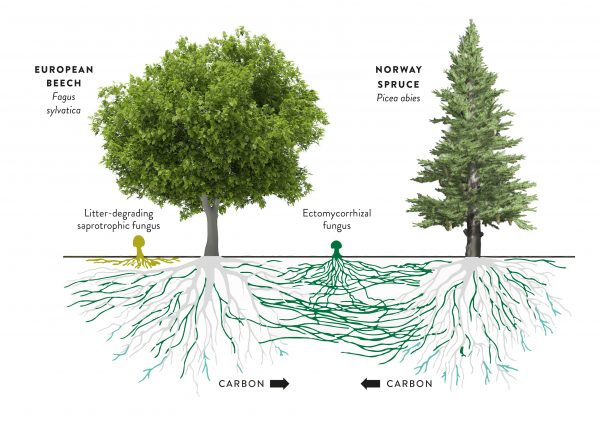
Dr. Klak considered. “Could be. You often see those kind of partnerships between conifers and deciduous trees, where the conifer supports the deciduous tree more during the spring [before the deciduous tree’s leaves have fully grown out] and the deciduous tree supports the conifer more in the summer. Could very well be.”
This filled me with happiness. The idea of potentially rekindling such an intimate interspecies bond seemed to add a whole new dimension to the American chestnut restoration project. Perhaps, if we might grossly anthropomorphize, the eastern white pines would be grateful for the surprise return of their long-lost friends.
As my visit wrapped up, Dr. Klak told me a personal anecdote further illustrating the latent potential of the American landscape that his project is helping to reclaim. Maine had weathered a recent ice storm, which caused the fall of a massive eastern hemlock tree (Tsuga canadensis, not to be confused with the poisonous hemlock plant) on his land. Eastern hemlocks can live 800 years, and Dr. Klak had assumed that his was a quite old tree, but to his surprise, counting the rings after it fell revealed that it was only 117, sprouting during the Roosevelt Administration. What appears to be an ancient tree by 21st-century standards was still relatively young, and could have grown much, much larger if given the chance.
“We have no idea what a natural landscape is,” he said. “That 117-year-old tree was thought of as a big old tree, but it was a little kid tree.” Most of the forest in Maine is recent second-growth, just a few decades old. In the 1800s and early 1900s, most of the state was farmland, and there hasn’t been time yet for really big, old trees to grow back. Our forests in 21st-century New England are great to have and provide tons of wonderful benefits to wildlife and people, but they’re just getting started. By the 2100s and 2200s, the forests of Maine may well have regrown some true giants.
And, of course, they’re currently missing the American chestnut, a keystone species that provided a rich nut crop every year with more nutrients than acorns. When Dr. Klak’s work, and the broader chestnut restoration efforts, have brought back this “wonder tree” in large numbers, the ecological carrying capacity of New England forests will increase substantially. More food available means more wildlife. After the biological turmoil of the last few centuries, scientists are laying the foundations for a true golden age of the Eastern Woodlands.

“If you’re going to restore a single plant to the eastern U.S.,” Dr. Klak said as we parted, “it’s got to be the chestnut. It fills the missing hole in the eastern forest landscape. Nothing better.”
What exactly is the difference between a seedling and a sapling? Basically the difference between a baby and a toddler, so to speak: seedlings are “just out of the seed,” generally less than one year old and still very fragile, while saplings have developed a woody trunk and branches. Dr. Klak’s lab had plenty of both.
Another difference is that the Darling54 lineage has the vital OxO transgene coding for oxalate oxidase on chromosome 4, and inside a chestnut coding gene, while the Darwin lineage has the same gene on chromosome 9, in a region without coding gene disruption. The Agrobacterium vector happened to place the gene at different places on the chestnut genome.



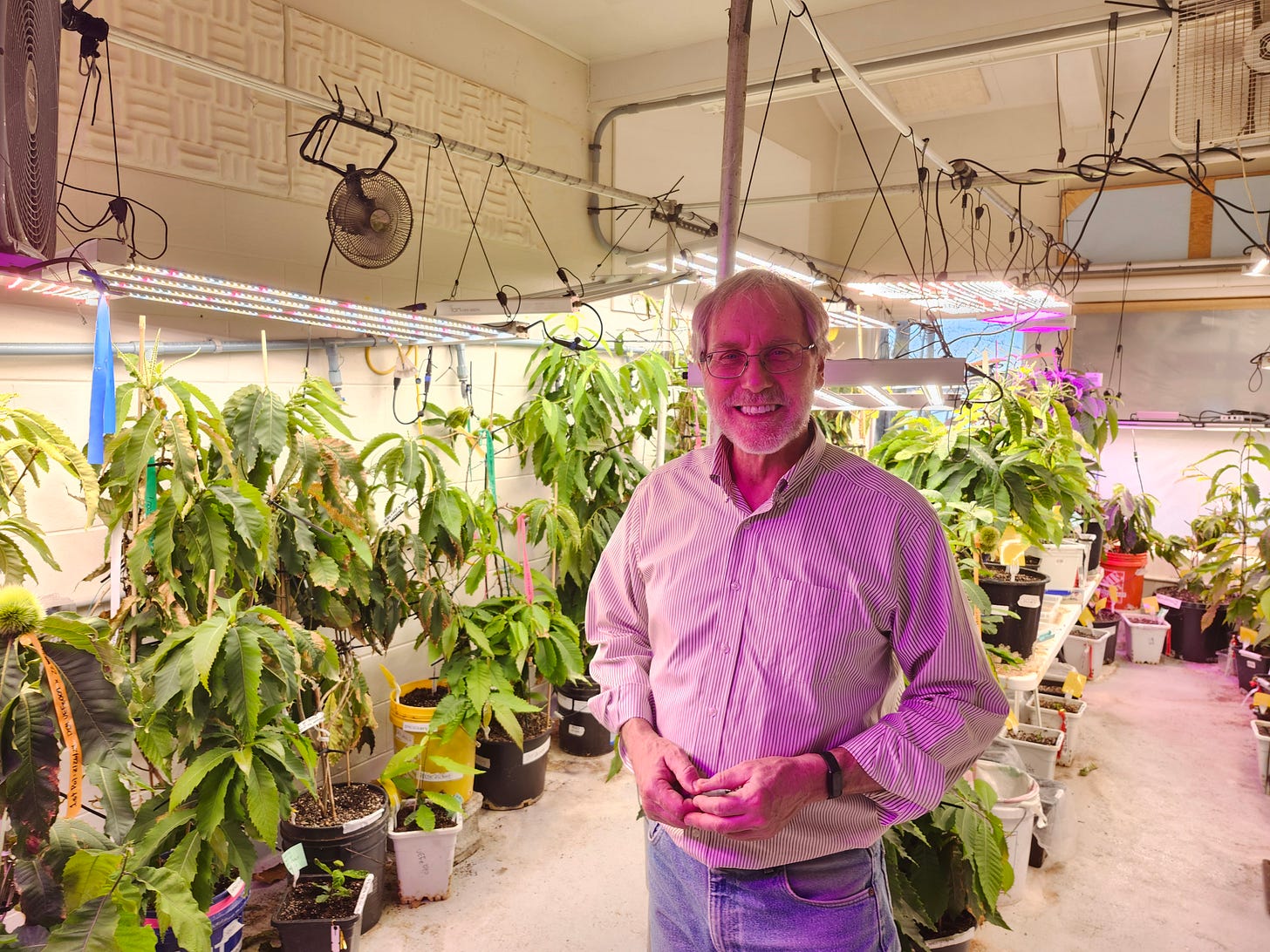
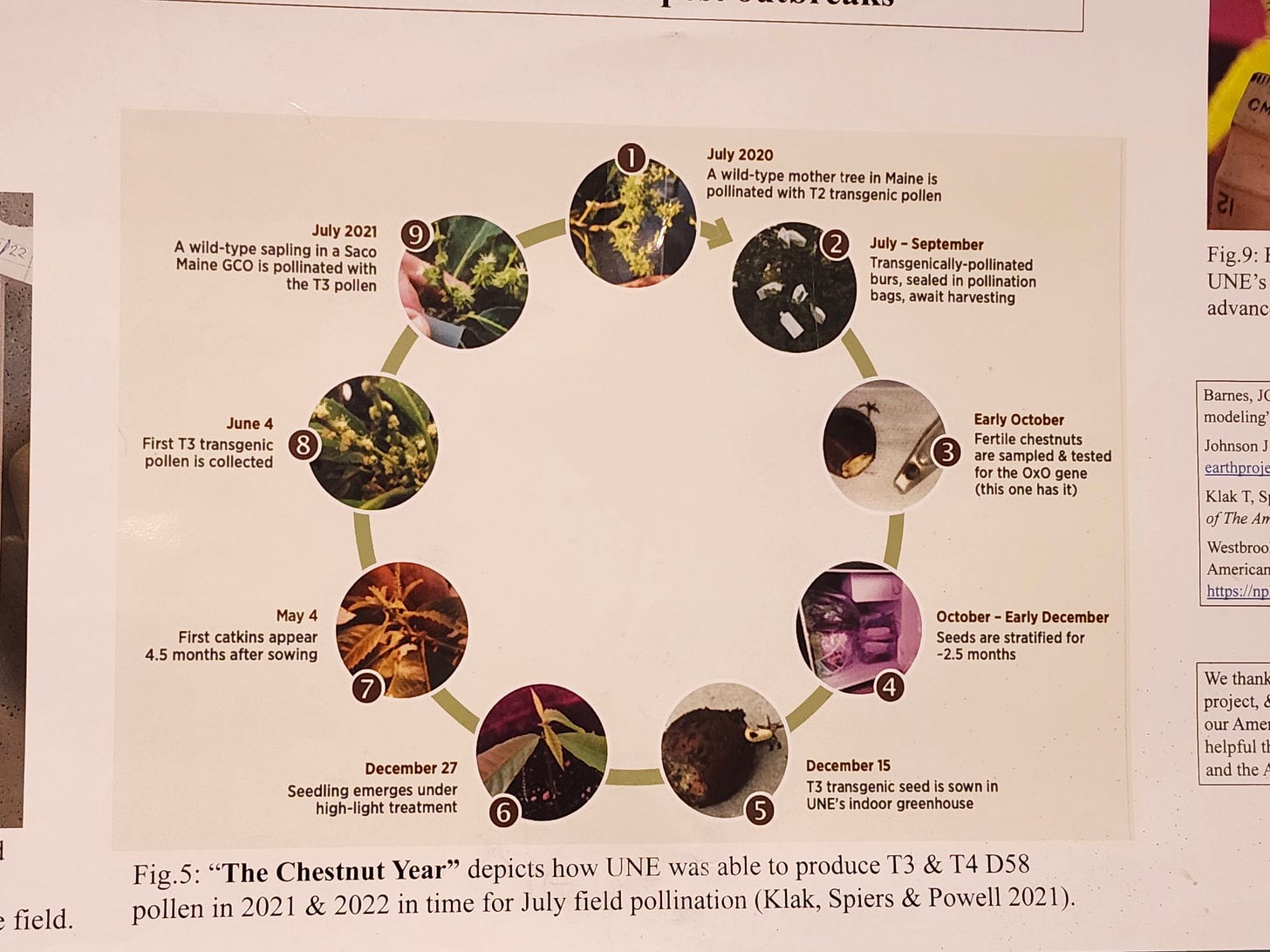
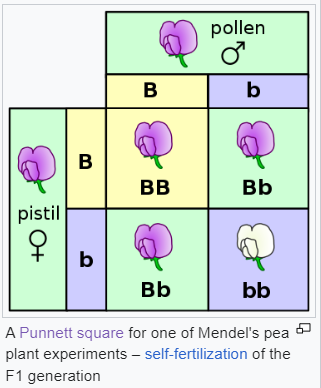
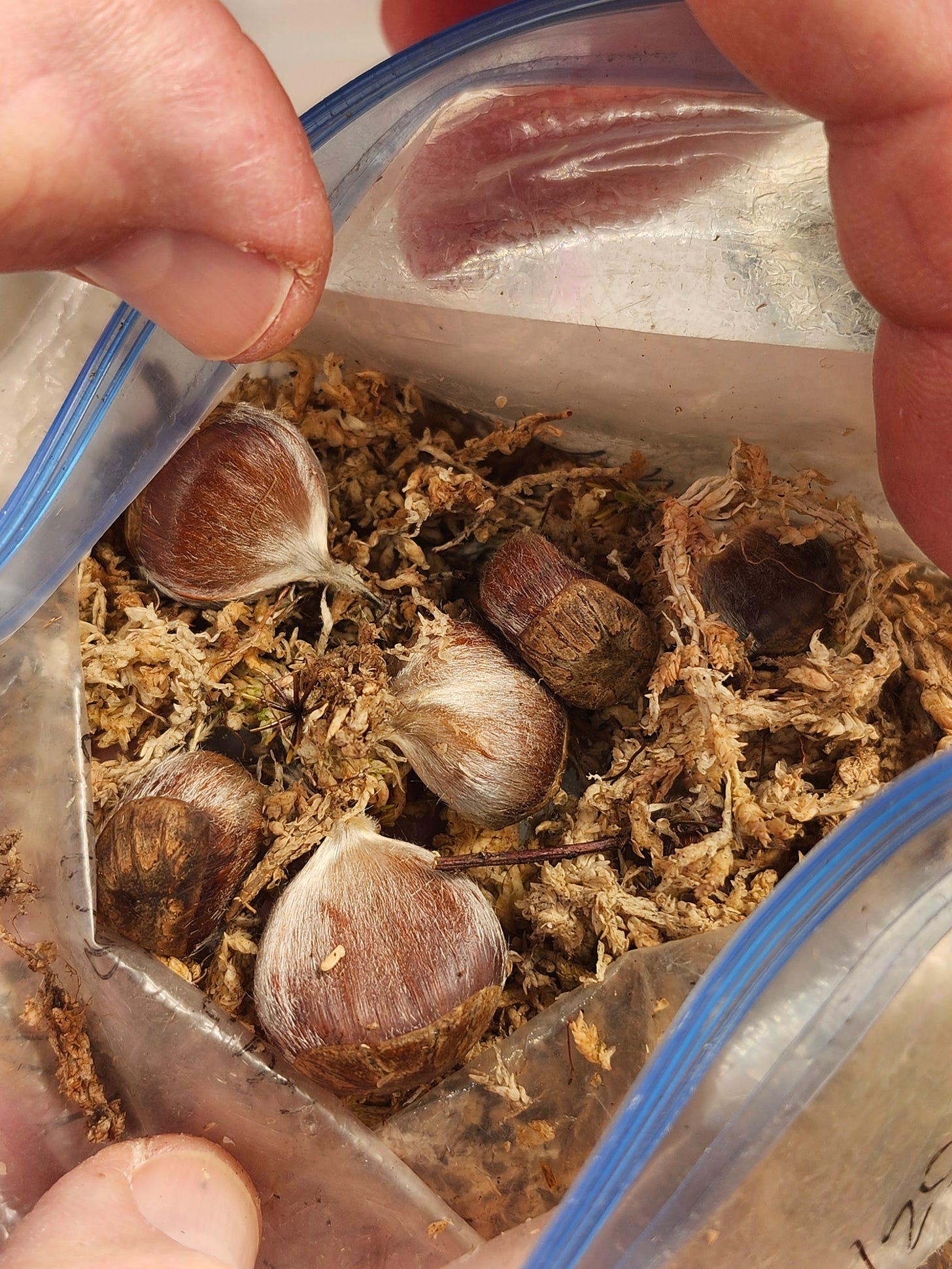
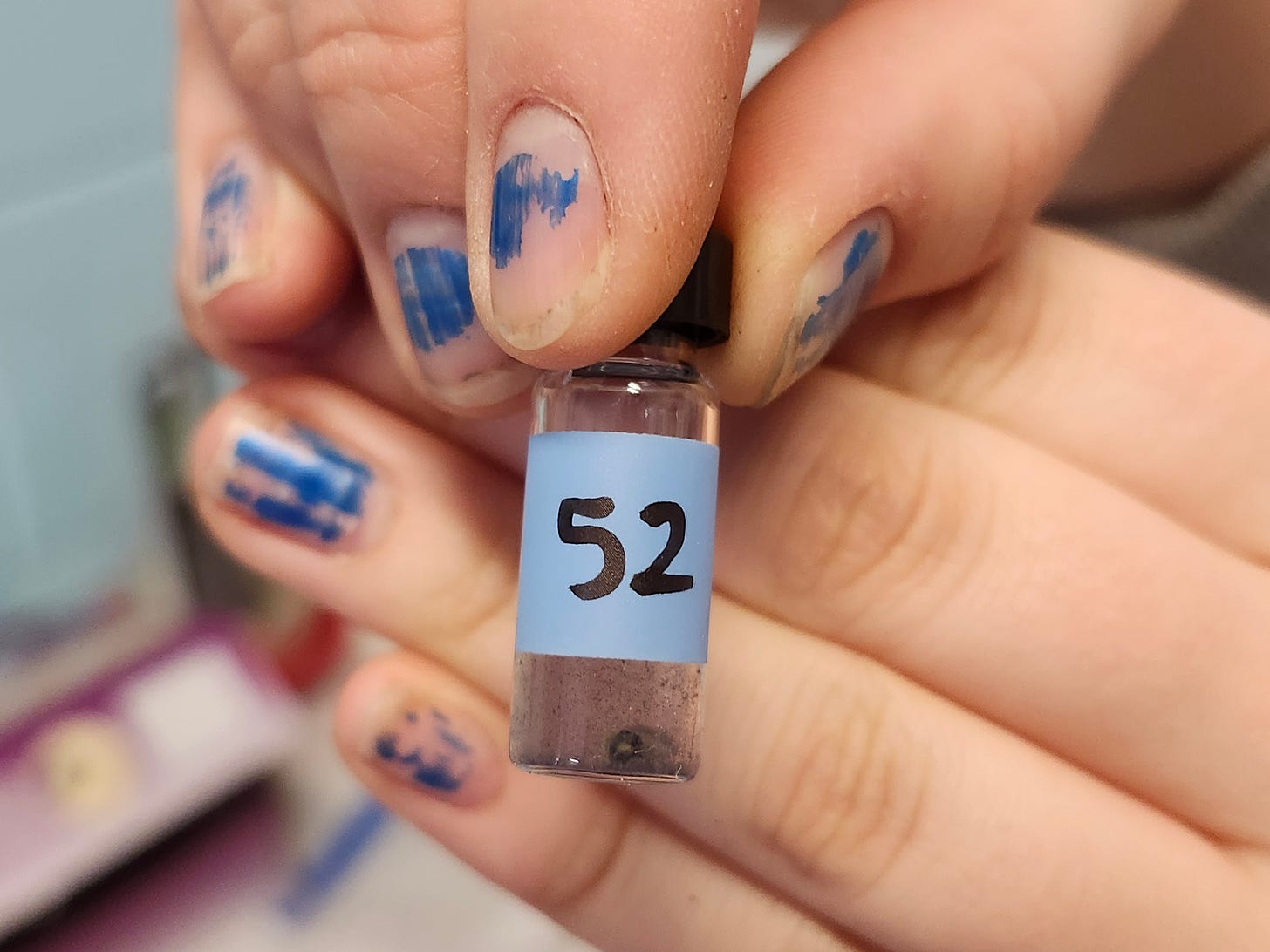
so many important pieces in this! thanks
if anyone would like to submit a comment to the USDA supporting the deregulation of the American chestnut tree with the extra gene to protect it against fungal blight, here’s the link, you can just write a sentence or two before July 21:
https://www.federalregister.gov/documents/2025/06/06/2025-10226/state-university-of-new-york-college-of-environmental-science-and-forestry-availability-of-a-revised